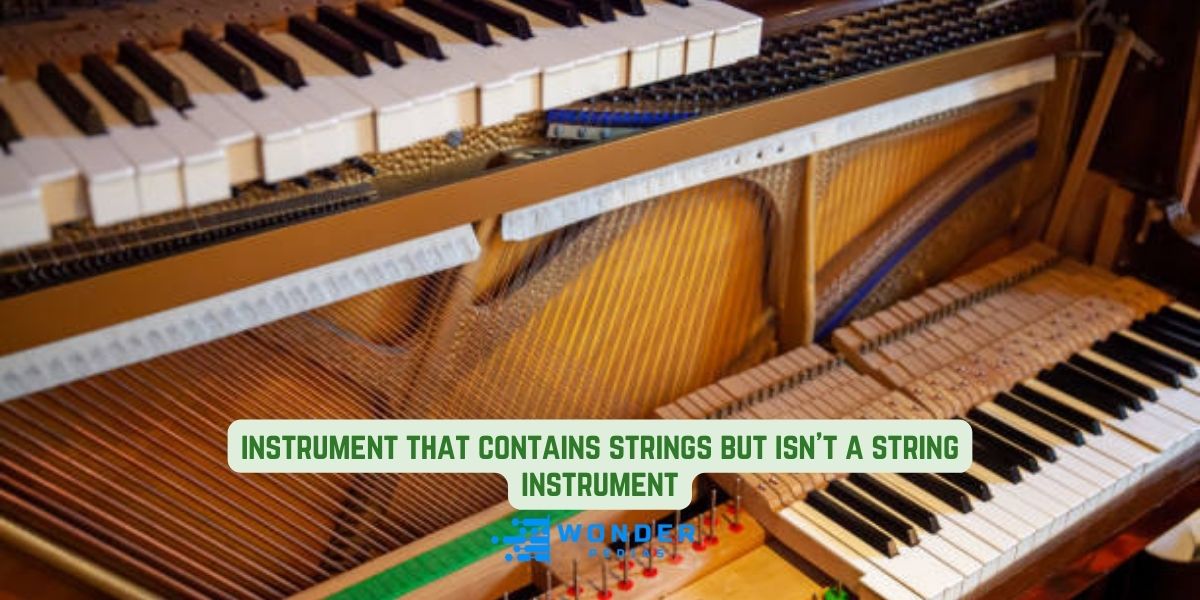Musical instruments are a fascinating blend of artistry and science. They are categorized into various families, each with its unique characteristics and sound production methods. The most common families are string, wind, percussion, and keyboard instruments.
However, there’s a curious anomaly in this categorization: an instrument that contains strings but isn’t a string instrument. This intriguing query often sparks curiosity and leads to exploration of less-known or unconventional instruments.
Understanding this distinction is crucial for musicians, music students, and anyone with a passion for music. It helps us appreciate the diverse world of instruments and the innovative ways in which sound is produced.
What Exactly is a String Instrument?
A string instrument is a musical marvel that produces sound through the vibration of stretched strings. These strings are typically crafted from materials like gut, nylon, or metal, and are meticulously tensioned between a bridge and tuning pegs. When these strings are set in motion, whether by plucking, bowing, or striking, they vibrate, generating sound waves that resonate through the instrument’s body.
The specific method of sound production plays a crucial role in shaping the instrument’s timbre and overall sound. For instance, plucked instruments like guitars and harps rely on the musician’s fingers or a plectrum to initiate the vibration. Bowed instruments, such as violins and cellos, utilize a horsehair bow to draw across the strings, creating sustained tones. Lastly, struck instruments like pianos and harpsichords employ hammers or plectra to strike the strings, resulting in percussive sounds.
The Science Behind the Sound
The tension of the strings is a critical factor in determining the pitch of the sound produced. By tightening or loosening the strings, musicians can adjust the frequency of vibration, resulting in higher or lower notes. This delicate balance between tension and pitch is essential for tuning and playing the instrument accurately.
The body of the instrument, often referred to as the soundbox or resonator, plays a vital role in amplifying and shaping the sound. The shape, size, and material of the soundbox influence the instrument’s tonal quality and resonance. For example, a violin’s hollow wooden body amplifies the vibrations of the strings, creating a rich and resonant sound.
By understanding the fundamental principles of string instruments, we can appreciate the intricate interplay between the strings, the body, and the musician’s technique.
Contents
- 1 What Exactly is a String Instrument?
- 2 What Makes an Instrument That Contains Strings but Isn’t a String Instrument Different?
- 3 Exploring the Instrument Families: Where Do These Instruments Fit?
- 4 Cultural and Historical Context of String-Like Instruments in Non-String Families
- 5 Examples of Instruments That Contain Strings But Aren’t String Instruments
- 6 The Difference Between Plucked, Struck, and Bowed Instruments
- 7 Practical Implications for Musicians and Composers
- 8 Conclusion: Understanding the Complexities of Instrument Classification
- 9 FAQ: Instruments That Contain Strings But Aren’t String Instruments
- 9.1 Q. What is an instrument that contains strings but isn’t a string instrument?
- 9.2 Q. Why are these instruments not classified as string instruments?
- 9.3 Q. What are some examples of these instruments?
- 9.4 Q. How are these instruments classified?
- 9.5 Q. Why is it important to understand the classification of these instruments?
What Makes an Instrument That Contains Strings but Isn’t a String Instrument Different?
While the term “instrument that contains strings but isn’t a string instrument” might seem counterintuitive, it highlights a unique category of musical instruments. These instruments possess strings, but their primary sound production method doesn’t involve directly vibrating the strings in the traditional sense of string instruments like violins or guitars.
The Key Distinction
The defining characteristic of these instruments is that the strings are not the primary source of sound. Instead, they serve as resonators that amplify the sound produced by another mechanism. This mechanism, whether it’s a hammer, a plectrum, or a key, strikes the strings, causing them to vibrate and produce sound.
Examples of Instruments That Fit This Definition
- Piano: Perhaps the most recognizable example, the piano is often mistakenly categorized as a string instrument. However, its sound is produced by hammers striking the strings, making it a percussion instrument. The strings act as resonators, amplifying the sound created by the impact of the hammers.
- Harp-Like Percussion Instruments:
- Celesta: This instrument, often used in orchestral and solo performances, resembles a small upright piano. It features a keyboard that activates hammers to strike tuned metal strings. The resulting sound is a delicate and bell-like tone.
- Tanggu: A Chinese percussion instrument, the tanggu is a type of drum with strings stretched across the drumhead. When the drumhead is struck, the strings vibrate sympathetically, adding a unique timbre to the sound.
- Instruments with Resonating Strings:
- Hammered Dulcimer: This instrument features strings stretched across a soundboard. The strings are struck with small hammers, producing a bright and percussive sound. The strings vibrate in response to the impact, amplifying the sound.
These instruments, while possessing strings, are classified differently due to their unique sound production mechanisms. By understanding this distinction, we can appreciate the diverse world of musical instruments and the innovative ways in which sound is created.
Exploring the Instrument Families: Where Do These Instruments Fit?
Percussion Instruments with Strings
While these instruments may contain strings, they are primarily classified as percussion instruments. This is because their sound is produced by striking the strings, rather than by plucking or bowing them. The strings in these instruments act as resonators, amplifying the sound produced by the impact of the hammers or mallets.
A prime example of such an instrument is the piano. Despite having numerous strings, the piano is categorized as a percussion instrument. When a key is pressed, a hammer strikes the corresponding string, causing it to vibrate and produce sound. The strings themselves do not produce the initial sound; the impact of the hammer is the primary source of vibration.
Similarly, the celesta is another instrument that fits this category. It features a keyboard that activates hammers to strike tuned metal strings. The resulting sound is a delicate and bell-like tone, produced by the percussion of the hammers on the strings.
Hybrid Instruments
Some instruments blur the lines between string and percussion instruments. These hybrid instruments combine elements of both families, making their classification somewhat ambiguous.
One such instrument is the cimbalom, a Hungarian hammered dulcimer. It features a large soundboard with rows of strings that are struck with hammers. While the strings are essential for producing sound, the primary sound source is the impact of the hammers. This makes the cimbalom a hybrid instrument, sharing characteristics of both string and percussion instruments.
Another example is the glockenspiel. This instrument consists of a series of tuned metal bars that are struck with mallets. While the bars themselves are not strings, they vibrate like strings when struck, producing a clear and bright sound.
Why This Classification Matters
Understanding the classification of instruments is crucial for several reasons:
- Musical Theory: It helps us comprehend the underlying principles of sound production and how different instruments contribute to the overall harmony and texture of a musical piece.
- Instrument Construction: Instrument makers need to understand the specific characteristics of each instrument family to design and build instruments that produce the desired sounds.
- Musical Performance: Musicians need to be aware of the unique playing techniques and performance considerations associated with each instrument family.
- Music Education: By understanding these distinctions, music educators can effectively teach students about the various instrument families and their roles in music.
By recognizing the nuances of instrument classification, we can appreciate the rich diversity of musical instruments and the innovative ways in which sound is produced.
Cultural and Historical Context of String-Like Instruments in Non-String Families
Origins of Hybrid Instruments
The evolution of musical instruments is a fascinating journey that spans millennia. In the early days of music-making, instruments often blurred the lines between categories. One such category is that of instruments that contain strings but aren’t strictly classified as string instruments. These hybrid instruments, often born out of experimentation and cultural exchange, have played a significant role in shaping the history of music.
Early keyboard instruments, such as the harpsichord, are prime examples of such hybrid instruments. While they possess strings, their sound is produced by plucking the strings with plectra, which are activated by keys. This mechanism, though involving strings, places the harpsichord firmly in the keyboard instrument family.
Evolution of Instrument Classification
As music evolved and instrument-making techniques advanced, so too did our understanding of instrument classification. Early systems of classification were often based on the materials used, the method of sound production, or the cultural context in which the instrument was used. However, as instruments became more complex and diverse, a more nuanced approach was needed.
The concept of an “instrument that contains strings but isn’t a string instrument” emerged as a way to categorize instruments that defied traditional classifications. This categorization helps us to better understand the unique characteristics of these instruments and their place within the broader musical landscape.
It’s important to note that cultural and historical factors have also played a significant role in shaping instrument classification. Different cultures have developed unique instruments that defy conventional categorization. For instance, many traditional instruments from Asia and Africa incorporate strings but are classified as percussion instruments due to their primary method of sound production.
By exploring the rich history and cultural significance of these hybrid instruments, we can gain a deeper appreciation for the diversity and innovation of musical instruments throughout history.
Examples of Instruments That Contain Strings But Aren’t String Instruments
While these instruments may possess strings, their primary method of sound production sets them apart from traditional string instruments like violins or guitars.
Piano: A Percussive Marvel
The piano, often considered a staple in musical ensembles, is a prime example of an instrument that contains strings but isn’t a string instrument. Despite its intricate system of strings, the piano is categorized as a percussion instrument.
When a pianist presses a key, a hammer is activated, striking the corresponding string. This impact causes the string to vibrate, producing sound. The strings themselves act as resonators, amplifying the sound produced by the hammer strike. The piano’s classification as a percussion instrument is rooted in this percussive mechanism, where the strings are secondary to the initial sound-producing action.
Celesta: A Delicate Percussion Instrument
The celesta is a keyboard instrument that produces a soft, bell-like sound. It features a set of tuned metal strings that are struck by hammers activated by a keyboard. While the presence of strings might suggest a classification as a string instrument, the percussive nature of the sound production mechanism places the celesta firmly within the percussion family.
The celesta’s delicate and ethereal sound has made it a popular instrument in orchestral and stage productions, often used to create magical and dreamlike atmospheres.
Hammered Dulcimer: A Percussive Harmony
The hammered dulcimer is an ancient instrument with a rich history. It features a trapezoidal soundboard with strings stretched across it. The strings are struck with small hammers, producing a bright and percussive sound.
While the strings are essential for producing the sound, the initial sound is generated by the impact of the hammers. This percussive element, coupled with the instrument’s unique construction, places the hammered dulcimer in the percussion family.
Other Notable Instruments
Other instruments that share this unique characteristic include:
- Clavichord: A keyboard instrument that produces sound when a key depresses a tangent, which strikes a string. While the strings are involved in sound production, the percussive action of the tangent places the clavichord in the keyboard instrument family.
- Harpsichord: Similar to the piano, the harpsichord features a keyboard that activates plectra to pluck the strings. The percussive action of the plectra, rather than the sustained vibration of the strings, is the primary sound source.
These instruments, while incorporating strings, defy traditional string instrument classifications due to their unique sound production mechanisms. By understanding these distinctions, we can appreciate the rich diversity of musical instruments and the innovative ways in which sound is produced.
The Difference Between Plucked, Struck, and Bowed Instruments
To understand the nuances of instruments that contain strings but aren’t classified as string instruments, it’s essential to delve into the fundamental distinctions between plucked, struck, and bowed instruments.
Plucked Instruments
Plucked instruments, such as guitars, harps, and lutes, produce sound when the strings are plucked with the fingers or a plectrum. The vibration of the strings, set in motion by the plucking action, creates the sound waves that we hear. The tension of the strings, the material they are made from, and the design of the instrument’s body all contribute to the unique timbre of each plucked instrument.
Struck Instruments
Struck instruments, like pianos and harpsichords, rely on hammers or plectra to strike the strings and produce sound. When a key is pressed on a piano, a hammer is activated, striking the corresponding string. Similarly, in a harpsichord, plectra pluck the strings. The impact of the hammer or plectrum on the string is the primary source of vibration, making these instruments more closely related to percussion instruments than string instruments.
Bowed Instruments
Bowed instruments, such as violins, violas, cellos, and double basses, produce sound by drawing a bow across the strings. The friction between the bow’s horsehair and the strings causes the strings to vibrate, creating a sustained tone. The bow’s pressure, speed, and angle of attack influence the timbre and intensity of the sound.
The Importance of Action in Classification
The method of sound production, or the “action,” is a crucial factor in classifying instruments. Instruments that rely on plucking, striking, or bowing are generally categorized as string instruments. However, as we’ve seen, instruments like the piano and harpsichord, while containing strings, are classified as percussion instruments due to their percussive action.
Why This Confusion Exists: The Case for Misclassification
The confusion surrounding the classification of certain instruments, such as the piano, often stems from a superficial understanding of their construction. The presence of strings can lead people to mistakenly categorize them as string instruments. However, as we’ve discussed, the primary sound-producing mechanism is the percussive action of the hammers.
Public perception can also contribute to this confusion. Seeing the visible strings on an instrument like a piano can lead people to assume that it is a string instrument, even though its sound is produced by striking the strings, not by plucking or bowing them.
By understanding the nuances of instrument classification and the importance of the sound production mechanism, we can appreciate the diversity and complexity of the musical instrument world.
Practical Implications for Musicians and Composers
Musicians’ Perspective
Understanding the distinction between an instrument that contains strings but isn’t a string instrument is crucial for musicians, especially when it comes to performance and interpretation. By recognizing the specific characteristics of these instruments, musicians can make informed decisions about their technique, phrasing, and tone production.
For example, pianists must understand the percussive nature of the piano, paying attention to articulation, dynamics, and touch. The way a pianist strikes the keys can significantly affect the sound produced. Similarly, celesta players must consider the delicate balance between percussive attack and sustained tone, carefully adjusting their touch to achieve the desired musical effect.
Composers’ Insights
Composers, too, benefit from a deep understanding of these instruments. When writing for an instrument like the piano, composers must consider its unique timbre and expressive capabilities. The piano’s ability to produce a wide range of dynamics, from soft pianissimo to powerful fortissimo, offers composers a versatile palette of sounds. By understanding the percussive nature of the piano, composers can write music that exploits its percussive qualities, such as rapid arpeggios or staccato chords.
For instruments like the celesta, composers can explore its ethereal and delicate sound to create atmospheric and dreamlike effects. The celesta’s ability to sustain notes and its shimmering quality make it a valuable tool for creating unique textures and harmonies.
Instrument Maintenance
The dual nature of these instruments also has implications for their maintenance. For example, pianos require regular tuning and maintenance to ensure that the strings are properly tensioned and the hammers are in good condition. The hammers, which are crucial for producing sound, can wear down over time, affecting the piano’s tone and responsiveness.
Celestas, on the other hand, require careful tuning and maintenance of their metal strings. The strings must be kept clean and free of corrosion to ensure optimal sound production. Additionally, the hammers that strike the strings should be regularly adjusted to maintain consistent tone and responsiveness.
By understanding the specific needs of these instruments, musicians and technicians can ensure their longevity and optimal performance.
Also Read: What Does “Totally Wackadoodle” Mean? | Origins & Usage
Conclusion: Understanding the Complexities of Instrument Classification
The concept of an “instrument that contains strings but isn’t a string instrument” might initially seem paradoxical. However, a deeper dive into the world of music reveals the intricate nuances that define instrument classification.
The primary factor that distinguishes these instruments from traditional string instruments is the method of sound production. While they may possess strings, the strings are not the primary source of vibration. Instead, these instruments rely on hammers, plectra, or other mechanisms to strike or pluck the strings, resulting in a percussive or plucked sound.
Understanding these distinctions is essential for musicians, composers, and music enthusiasts. It allows us to appreciate the diversity of musical instruments and the innovative ways in which sound can be produced. By recognizing the unique characteristics of these instruments, we can gain a deeper understanding of their role in musical performance and composition.
We invite you to explore further the fascinating world of instruments that defy traditional classification. Share your thoughts, experiences, and questions in the comments section below. Let’s continue the conversation and delve deeper into the intricacies of musical instruments.
FAQ: Instruments That Contain Strings But Aren’t String Instruments
Q. What is an instrument that contains strings but isn’t a string instrument?
A: An instrument that contains strings but isn’t a string instrument is a musical instrument that uses strings to produce sound but doesn’t rely on the traditional methods of plucking, bowing, or strumming strings. Instead, these instruments utilize percussive or keyboard-based mechanisms to activate the strings.
Q. Why are these instruments not classified as string instruments?
A: The primary reason these instruments aren’t classified as string instruments is their unique sound production method. Unlike traditional string instruments, they don’t rely solely on the vibration of the strings to produce sound. Instead, they utilize hammers, plectra, or keys to strike or pluck the strings, resulting in a percussive or keyboard-based sound.
Q. What are some examples of these instruments?
A: Some common examples of instruments that contain strings but aren’t classified as string instruments include:
- Piano: A keyboard instrument where hammers strike strings to produce sound.
- Celesta: A keyboard instrument with metal bars that are struck by hammers, producing a delicate, bell-like sound.
- Hammered Dulcimer: A percussion instrument with strings that are struck by hammers.
- Harpsichord: A keyboard instrument where plectra pluck strings to produce sound.
Q. How are these instruments classified?
A: These instruments are typically classified as percussion or keyboard instruments based on their primary sound production mechanism.
Q. Why is it important to understand the classification of these instruments?
A: Understanding the classification of these instruments is crucial for musicians, composers, and music enthusiasts. It helps us to appreciate the diverse world of musical instruments and the innovative ways in which sound can be produced. Additionally, it helps us to understand the specific techniques and nuances required to play these instruments effectively.





